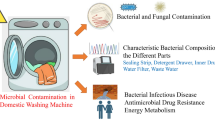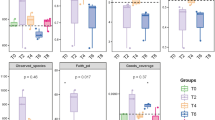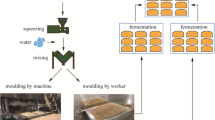Abstract
Health and environmental protection are the development trend of household appliances, coupled with the impact of the COVID-19 epidemic in the past few years. Consumers have unprecedented concerns and expectations about the sterilization and disinfection functions of household appliances. As a washing and nursing equipment for household clothes, the anti-bacterial technology of washing machine has developed rapidly. The new models of washing machines in the market have basically added the function of sterilization. In order to thoroughly solve the problem of sterilization and bacteriostasis of washing machines from the source, the distribution of microbial contamination in washing machines should be fully investigated. At present, there is almost no systematic study on the microbial community structure in washing machines in China. Therefore, the purpose of this study is to analyze the bacterial community structure in Chinese household washing machines. To explore the key factors affecting the bacterial community structure of washing machines. Bacterial communities were comprehensively analyzed by high throughput sequencing. Using chao and shannon indexes as indicators, one-way ANOVA was used to explore the key factors affecting the bacterial community structure of washing machines. A total of 2,882,778 tags and 21,265 OTUs from 522 genera were sequenced from 56 washing machine samples. Genus Mycobacterium, Pseudomonas, Brevundimonas, Sphingomonas, Sphingobium, Enhydrobacter, Methylobacterium, Pseudoxanthomonas, Stenotrophomonas and Sphingopyxis were the top ten bacteria genera in abundance. The effects of sources, types, frequency of utilization, sampling locations and service life of washing machines on bacterial diversity in washing machine were systematically analyzed. The statistical analysis showed that service life was an important factor affecting bacterial diversity in washing machine. Our study lays a foundation for directional screening of characteristic microorganisms with targeted characters including malodor-producing, fouling, pathogenic and stress-resistance, the antibacterial evaluation, metabolic mechanism of key characteristic microorganisms as well as antibacterial materials development. At present, the sterilization technology of washing machines has not been fully in combination with the distribution survey of microorganisms in washing machines. According to the specific microorganism distribution condition of the washing machine, the key distribution positions and the types of specific microorganisms contained in different positions, conduct more targeted sterilization treatment. This will help to completely solve the problem of microbial growth in washing machines from the source.







Similar content being viewed by others
References
Babic MN, Zalar P, Zenko B et al (2015) Candida and Fusarium species known as opportunistic human pathogens from customer-accessible parts of residential washing machines. Fungal Biol 119(2–3):95–113
Bolyen E, Rideout JR, Dillon MR et al (2019) Reproducible, interactive, scalable and extensible microbiome data science using QIIME 2. Nat Biotechnol 37:852–857
Callahan BJ, Mcmurdie PJ, Rosen MJ et al (2016) DADA2: high-resolution sample inference from illumina amplicon data. Nat Methods 13:581–583
Dogen A, Sav H, Gonca S et al (2017) Candida parapsilosis in domestic laundry machines. Med Mycol 55(8):813–819
Gattlen J, Amberg C, Zinn M et al (2010) Biofilms isolated from washing machines from three continents and their tolerance to a standard detergent. Biofouling 26(8):873–882
Hou T (2021) Health and intelligence make washing machine have high premium ability. Househ Appl 5:76–77
Jacksch S, Kaiser D, Weis S et al (2019) Influence of sampling site and other environmental factors on the bacterial community composition of domestic washing machines. Microorganisms 8(1):30–46
Jacksch S, Zohra H, Weide M et al (2021) Cultivation-based quantification and identification of bacteria at two hygienic key sides of domestic washing machines. Microorganisms 9(5):905
James AG, Austin CJ, Cox DS et al (2013) Microbiological and biochemical origins of human axillary odour. FEMS Microbiol Ecol 83(3):527–540
Li Y, Liang C, Sun H et al (2016) Microbial contamination of common household washing machines. Chin J Infect Control 15(5):313–316
Ling H (2021) Key words of washing machine industry development in 2020. Househ Appl 2:66–67
Logan NA, De Vos P (2009) Genus Stenotrophomonas. Don J. Brenner,Noel R. Krieg,James T. Staley (editors). Bergey’s Manual of Systematic Bacteriology[M]. 2nd ed. New York: Springer; 107–117.
Lu J (2018) Improve the antibacterial and sterilization ability of household appliances and promote the construction of healthy China. Home Appl Technol 07:2
Nix ID, Frontzek A, Bockmühl DP (2015) Characterization of microbial communities in household washing machines. Tenside Surfactants Deterg 52(6):432–440
Stapleton K, Hill K, Day K et al (2013) The potential impact of washing machines on laundry malodour generation. Lett Appl Microbiol 56(4):299–306
Su L (2019) Clean Life · health care washing machine segmentation market accumulates new kinetic energy. Househ Appl 11:100–101
Tischner Z, Kredics L, Marik T et al (2019) Environmental characteristics and taxonomy of microscopic fungi isolated from washing machines. Fungal Biol 123(9):650–659
Xu J (2021) The main battlefield shifts and the value war starts in china’s washing machine market. Electr Appl 3:23–25
Xu H, Su J, Ruan S et al (2005) Investigation on microbial contamination of household washing machines in Shanghai. Shanghai J Prev Med 5:225–226
Zhang Y (2021) Healthy, intelligent and innovative, the washing machine market is advancing at the right time. Electr Appl 3:17–19
Zhang X, Zhang X (2012) Study on microbial contamination of household washing machine. Environ Sci Manage 37(8):73–74
Zhang X, Tian X, Ma L et al (2015) Biodiversity of the symbiotic bacteria associated with toxic marine dinoflagellate Alexandrium tamarense. J Biosci Med 3(6):23–28
Author information
Authors and Affiliations
Contributions
YC, SY and LP wrote the main manuscript text and JX prepared figures and tables. All authors reviewed the manuscript.
Corresponding authors
Ethics declarations
Conflict of interest
The authors declare no competing interests.
Additional information
Publisher’s Note
Springer nature remains neutral with regard to jurisdictional claims in published maps and institutional affiliations.
Rights and permissions
Springer Nature or its licensor (e.g. a society or other partner) holds exclusive rights to this article under a publishing agreement with the author(s) or other rightsholder(s); author self-archiving of the accepted manuscript version of this article is solely governed by the terms of such publishing agreement and applicable law.
About this article
Cite this article
Cao, Y., Yuan, S., Pang, L. et al. Study on microbial diversity of washing machines. Biodegradation (2024). https://doi.org/10.1007/s10532-023-10069-8
Received:
Accepted:
Published:
DOI: https://doi.org/10.1007/s10532-023-10069-8




